Student Blog
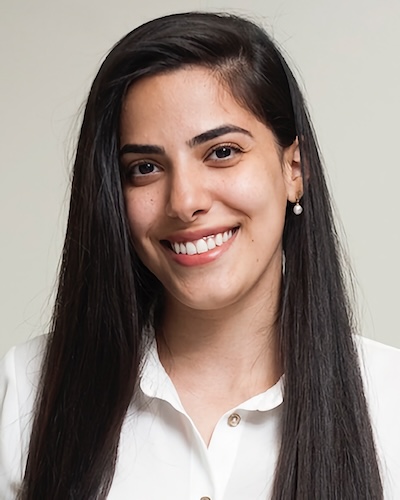
Why Did I Become an Occupational Therapist? ⟩
October 6, 2017, by Linah
Ever since I was little I loved helping people and found value in standing up for those who need it. I grew up in a household of doctors, so I have had a good idea about medicine and loved the science itself. Yet, I never saw myself as doctor. I found occupational therapy by accident. It was a new major in my university and when the time came to choose a specialty, I chose it based on eliminating other medical specialties. I did not know what occupational therapy is until my first class after I majored in it. And ever since, it was a love story for the ages. In occupational therapy I find room to be creative while still validating my ideas with scientific measures. It equips me as a practitioner with the knowledge needed to fully understand a client’s medical problem then provides the tools to find the best solution there is for that particular client.
Through offering customized practical solutions, occupational therapists are able to bridge the gap between culture and medicine on a client by client basis. And what better way is there to help implement change in social attitudes about health and disabilities? Another thing I love about occupational therapy is how it aims to empower its clients. The best way to represent a certain demographic is by enabling them to speak for their own. By educating them about their conditions, rights, and preparing them to face their societies with strength. As an occupational therapist I believe I am capable of doing so. I feel blessed to have found a career as enjoyable, and meaningful as occupational therapy.
⋯
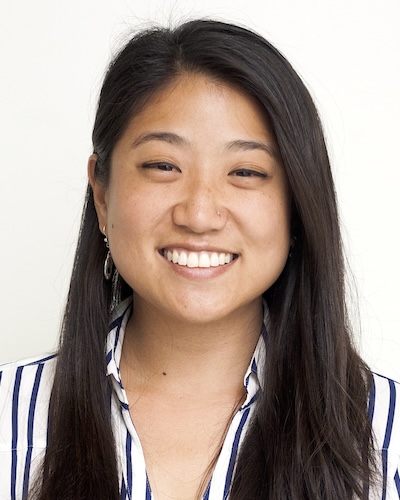
Standardized Patients: the Good, the Bad, and Becoming the Hulk ⟩
October 6, 2017, by Erika
One of the best opportunities our program offers is the chance to practice transfers with standardized patients in our Adult Rehab immersion.
What’s a standardized patient?
It’s a person carefully recruited and trained to take on the characteristics of a real patient providing students with the opportunity to learn skills in a simulated clinical environment. Neat, right?
So far in my adult rehab immersion, we’ve practiced with standardized patients “recovering from hip replacements, back injuries, and stroke.” We’ve learned how to transfer them from laying in bed to sitting then to a wheelchair or walker! From there, we’ve also practiced how to mobilize and transfer these patients to the shower, tub, and toilet.
It’s been ADLmania!!!
Our Adult Rehab lab was designed to simulate common practice locations where we would actually conduct transfers and treatment sessions. On one side, we have an exact replica of what a hospital room looks like at Keck Medical center — from the beds to the toilet and shower. On the other side, we have a standard bedroom with access to a tub and toilet. Lastly, we have a fully functioning kitchen where we can practice various occupations like meal prepping, washing dishes, and cooking. What’s better than practicing real life occupations in a real life setting?


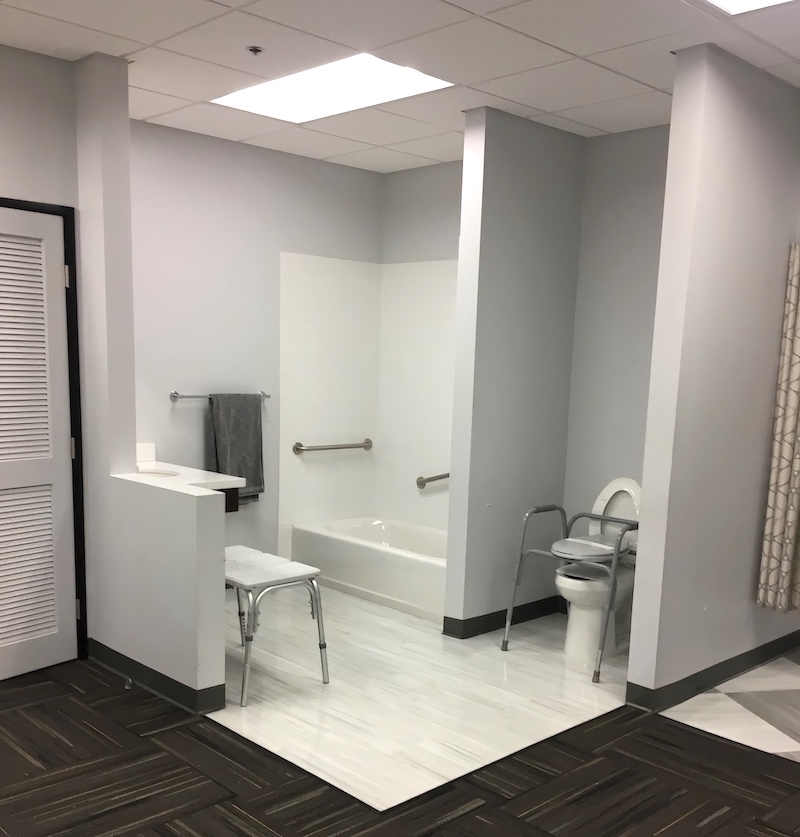
Readers, can I just say, the first time I practiced with standardized patients, I. Was. Terrified.
“I have NO clue what I’m doing. Are they going to be nice? Are they going to be painfully dramatic? Am I going to drop someone and break their hip a second time?”
My stream of consciousness spiraled into the dark depths of the unknown but of course, with all new experiences, it wasn’t as bad as I thought it was going to be.
Sure, I think all of us students will admit that the first time, there was a lot of “uhhhhh . . .”s, big perplexed eyes, and unnecessary overexplanations of the protocol running through our heads and out our mouths. After that though, you realize that the standardized patients aren’t there to give you a hard time or to give Oscar-worthy dramatic performances but are there for you and your learning experience. While at times, they were committed to simulating pain (which was intimidating at first), they were incredibly kind and open to providing feedback on why they felt pain or felt discomfort. They were gracious in giving us as many opportunities to try again to make sure we get a specific transfer or handling right.
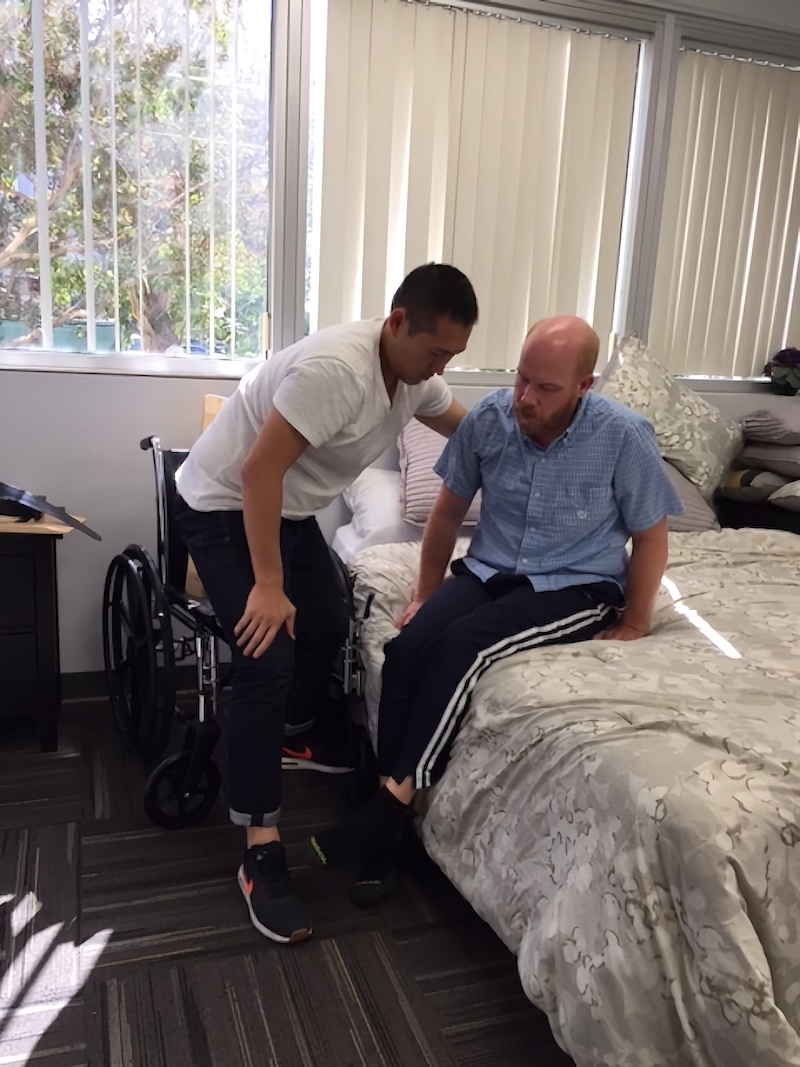
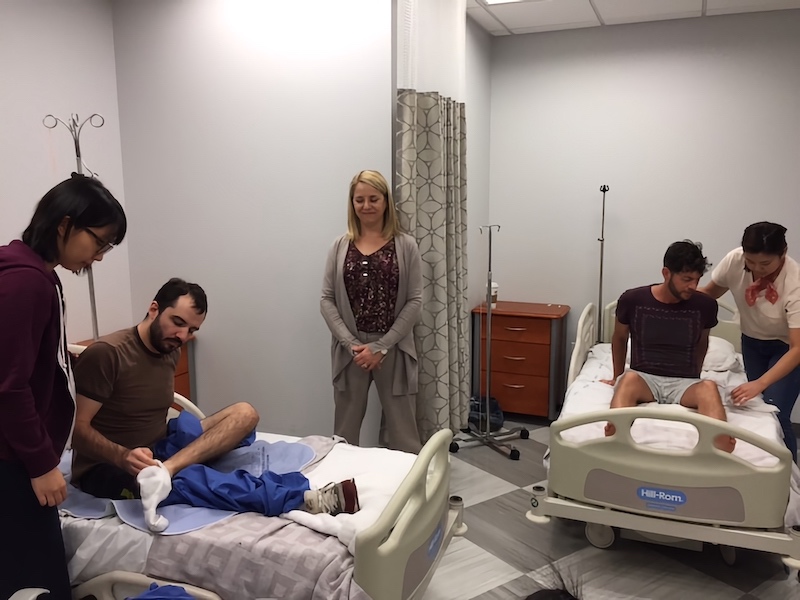
At the end of the day, that’s what makes the opportunity of practicing with standardized patients valuable — it gives us the opportunity to spiral into our own fears then build ourselves back up with the support and feedback of our professors and standardized patients to reveal our own capabilities and strengths — all within a safe learning environment!
I want to close with some advice I was given while working with a standardized patient named Mel*. After I had transferred him, he looked me straight in the eye and said, “You have to commit. If you don’t commit, I won’t commit.” I’m not sure if this was a reflection of his practices as a method actor, but it completely changed how I transferred after that point. I became more confident. You know when Bruce Banner becomes the Hulk? It was like that without all the rage. Mel’s words transformed my identity from being a timid inexperienced OT student to a potentially strong, capable, and committed OT practitioner. Thanks Mel.
*All names mentioned in this blogpost are pseudonyms.
⋯

Bachelor’s to Master’s in Occupational Therapy: A community not just a major ⟩
October 2, 2017, by Ali
We just hosted our OT Welcome Back Dinner for the Bachelor’s to Master’s Degree Program students. With 9-11 students per graduating class, the Accelerated BS to MA community is a very small and connected group. Dr. Joanne Park and the rest of the admissions team organize events, such as this dinner, as an opportunity to share a meal with all the OT majors who can make it. We organized dinner, games, and the chance to meet their mentor/mentee groups for the first time.
Each student is assigned a mentor group, which consists of at least one freshman, sophomore, junior, and senior as a resource to ask questions and help support one another. We encourage these mentor groups to engage in their favorite occupations together or study together on campus.
These events are designed to foster the community, or OT Family, of progressive degree occupational therapy students throughout their five years with the program. As these students are on a fast track professional degrees, we want to ensure they feel a part of the Chan Division of Occupational Science and Occupational Therapy. It is important to note the BS degree does not permit students to be licensed therapists, but they will be ready to sit for the national board exam and become a therapist even sooner because they only have one more year of school to complete their Master’s degree.
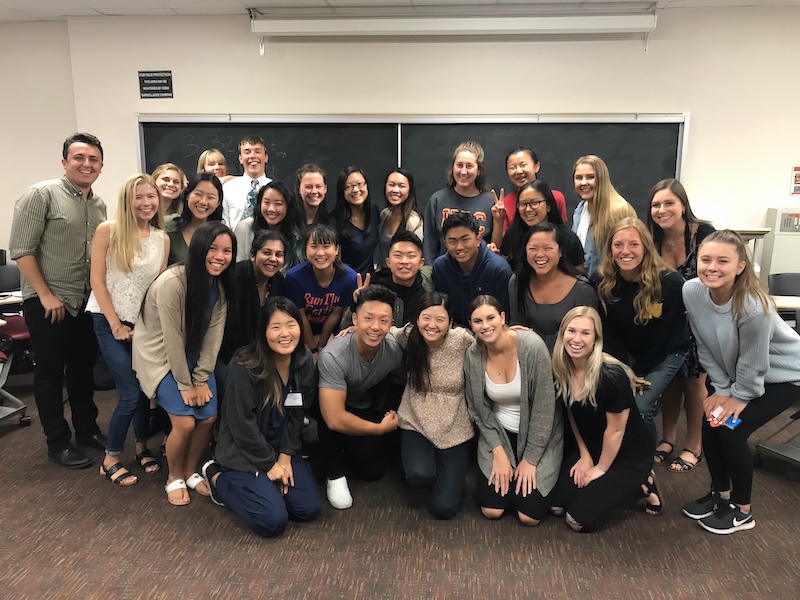
This is a picture of everyone who was able to come out for the dinner!
⋯
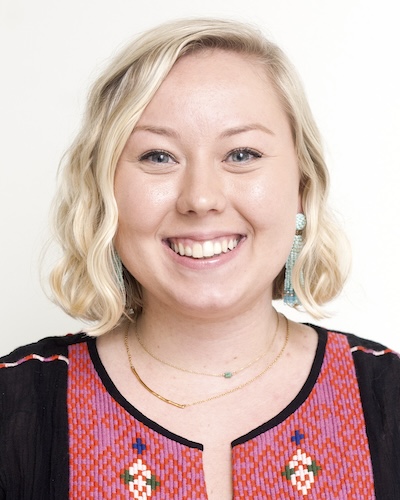
Let’s Talk Fieldwork — Part II: School-Based Pediatrics ⟩
September 28, 2017, by Caroline
In my previous blog post I explained how Level I and Level II Fieldwork experiences work in our program at USC, and shared about my previous Fieldwork placements. As promised, this blog is devoted to my current Level I Fieldwork experience!
I am in the Pediatrics Immersion, which means that my Fieldwork is also in a pediatric OT setting. I’ve been placed in a local school district, so I get to see school-based pediatrics. I was really excited when I first got my placement, because I had observed pediatrics before, but not in a school-based setting, so this would be a new experience for me! I spend most of my time at an elementary school, but my Clinical Instructor (CI) and I also go over to a local high school to treat some students there as well.
I just had my 3rd day at my Fieldwork site, and I have already gotten to observe and assist with so many different things! Because my CI has a pretty consistent schedule, I get to see the same kids each week. This allows me to see growth and change in the clients, helps them to become more comfortable with me, and gives me the opportunity to begin planning and leading treatments with them as I become more familiar with them, their goals, and their interests.
The elementary school where I’m placed has a pretty unique setup, because my CI has an awesome OT clinic room all to himself — mats, obstacle course, swings, and all! With all of the materials and resources, there are so many possibilities for treatment and intervention, which is so exciting!
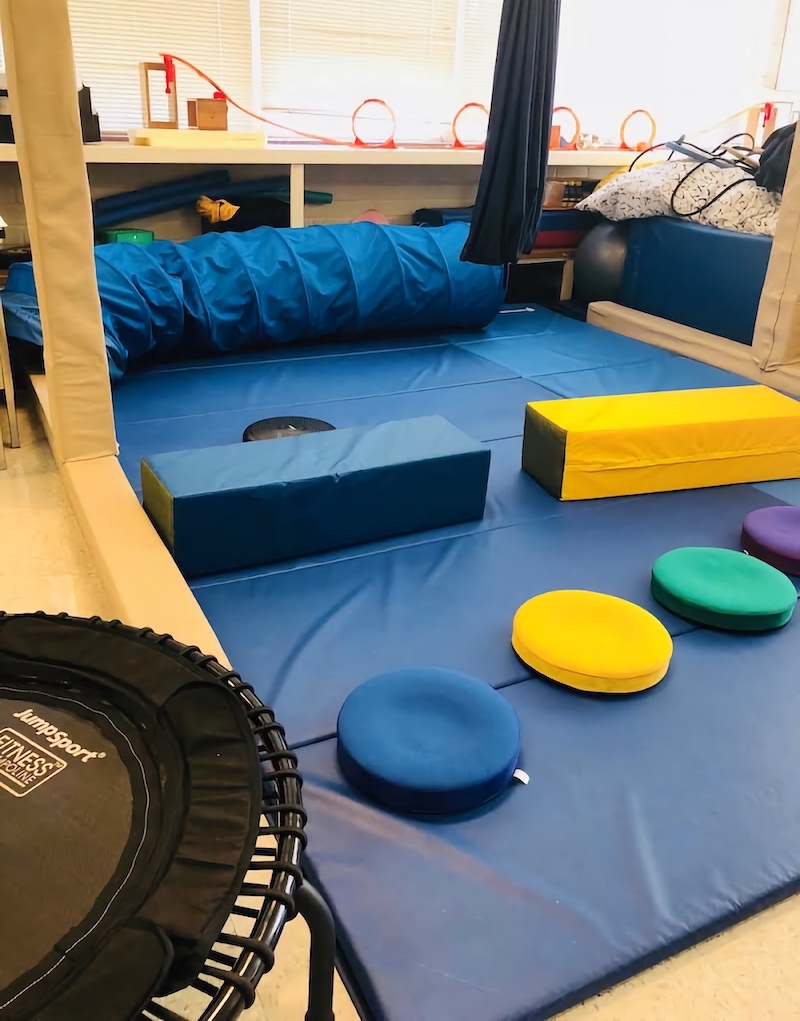
Here you can see the OT clinic space at the elementary school. Lots of space for obstacle courses, movement, and fun!
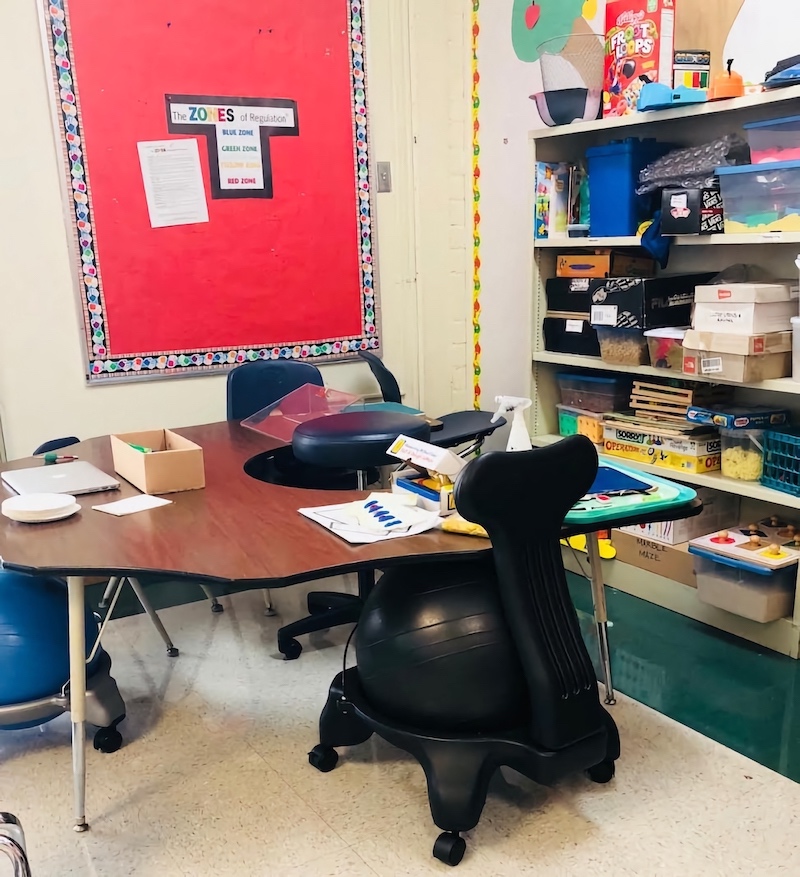
The OT clinic also has a great table-top setup to work on handwriting and other fine motor skills!
A Typical Morning at my School-Based Fieldwork Site
8:15 — Arrive, plan for the clients that day, prepare any materials needed.
9:00-9:30 — Pull a client out of class for an individual OT session. We used play-doh to work on hand strength, bilateral coordination (using both hands at the same time in a controlled manner), and pre-writing (by using the play-doh to spell out the client’s name).
9:30-10:00 — Pull another client out of class for an individual OT session. We used a three-step obstacle course in the clinic room to work on gross motor control (coordinating the large parts of your body, like legs, arms, and trunk to move) and task sequencing (progressing smoothly through a multi-step activity).
10:00-10:30 — Time for documentation and planning.
10:30-11:30 — We run an OT and Speech group with one of the Special Ed classrooms. We led the students through a song with choreographed dance moves (jumping, running in place, spinning) and then completed a craft activity based on the song that worked on fine motor skills (activities that require the use of the smaller body parts, such as the hands and fingers) like handwriting, cutting, coloring, tearing paper, and squeezing glue.
11:30-12:00 — Time for documentation and planning.
12:00-12:30 — Lunchtime (in the teacher’s lounge! It’s definitely not as mysterious as my elementary-school aged self thought it was 😊 ).
The mornings are pretty consistent, but the afternoons have a little bit more variability. Sometimes, we have meetings with parents and the rest of the team at school (Speech Therapists, Teachers, Psychologists, etc.) to address concerns or for an annual Individualized Education Program (IEP) meeting. At these meetings, it’s really cool to see the inter-disciplinary team working together to best support the individual child in the school environment. Other afternoons, we’ll go over to the nearby high school and work with some of the clients over there. I’ve enjoyed getting to see what school-based OT looks like for elementary-school aged children compared to high school students.
I’ve only had 3 days of Fieldwork, but I’m seeing individual clinic sessions with elementary and high-school aged students, group sessions, IEP and parent meetings, and more! My CI is also very open to me jumping in, taking charge, and planning and implementing some sessions with the kids. As I continue to learn more in my pediatrics class and am exposed to more at Fieldwork, I expect I’ll get more and more comfortable taking on more responsibility at Fieldwork!
My full week of fieldwork is coming up in a couple of weeks, so I’m looking forward to seeing even more clients! If you’ve observed OT in a school-based setting or have any questions about my experience, leave a comment below!
⋯

A Summer of Lessons From Master Wu ⟩
September 28, 2017, by Bryan
I never liked kids. Maybe it was growing up as an only child, or not liking loud noises or when things get too messy (sensory sensitivities . . .), I always distanced myself from having to interact with a child more than a quick smile or wave.
With that said, this past summer I spent my 12 weeks getting to know and treating children ages 4-11 at Stepping Stones Therapy Network, a pediatrics clinic in Seattle, WA. I took advantage of the out-of-area fieldwork request and took the opportunity to work in one of my favorite cities.
While I am planning to elaborate more on the process of securing an out-of-area level 2 placement and tips throughout the process in a future post, I wanted to share a few ways in which I grew as a clinician, student, and person after completing my Level 2 FW.
- I was so prepared! I cannot stress this enough. If you put in the work throughout the semester to learn the material and listen to faculty’s tips and tricks from their own practice, you will be ready for all that comes with Level 2 FW. The hardest part about Level 2 was not the clinical reasoning needed to observe and assess a client from the multitude of OT models of practice (Sensory Integration, Biomechanical, etc.), rather the ins and outs of learning how the clinic operates and becoming more proficient with administering and scoring assessments. One of the major encouragements my clinical instructors gave me was regarding my documentation skills which I directly attributed to the fact that I was taught the OT lens in class through the case studies we discussed and from faculty’s own stories and reflections.
- The learning does not stop. Even though I had no examinations or quizzes to study for, I spent each evening looking up treatment ideas for my clients the next day, documenting on the clients I saw that day, watching YouTube videos of BOT 2 administration for my evaluation later that week, reviewing Handwriting Without Tears, all the while trying to learn the names of Ninjago characters to better connect with the kids. Fieldwork is definitely full time!
- I learned to have a BLAST on the weekends! The good thing about fieldwork is that you do not have to feel the dull (sometimes sharp) pressure of an upcoming exam that impedes your ability to just hang out and chill. I went on a lot of fun hikes and really explored Seattle which only helped me focus and perform better when I was at fieldwork during the week! I loved having a routine throughout the week: working, gym, meal prep, treatment planning, reading, and enjoying the city and friends I had during the weekends.
- Make it a priority to build a relationship with your clinical instructors and coworkers. I guess this point was easy for me this summer because I was truly blessed with amazing CIs and coworkers who were not only skilled OTs, but also mindful instructors, carefully pacing my growth as a student and clinician. I wanted to be intentional with asking them about treatment ideas and career advice moving forward. What steps should I take to go into inpatient pediatrics? What do you like about working at a peds clinic? What certifications should I pursue?

Kayaking Lake Union on Weekends

Hiked Heather Lake in June
Seattle summer weather is unreal . . .
⋯





